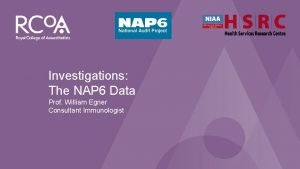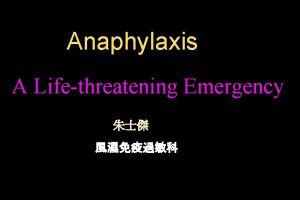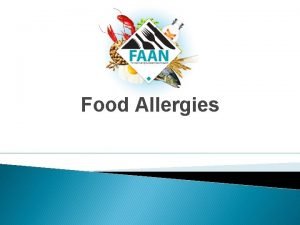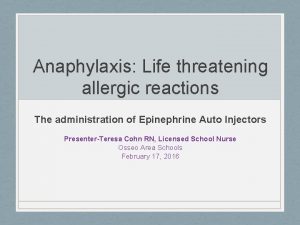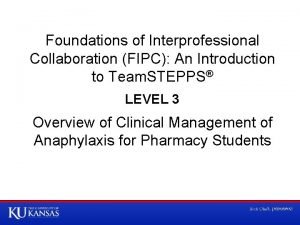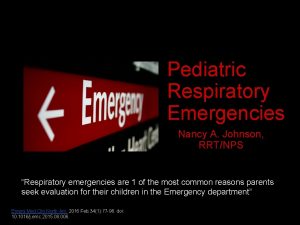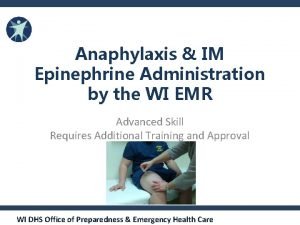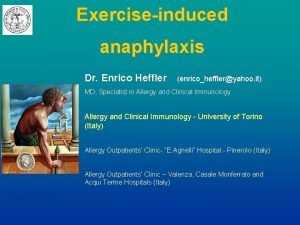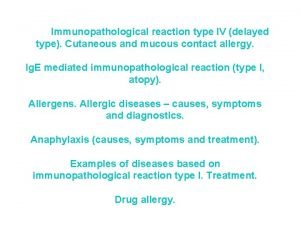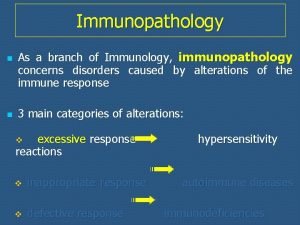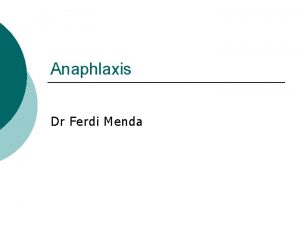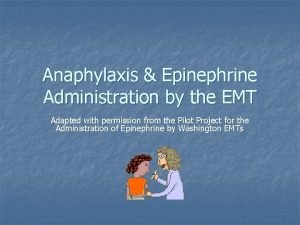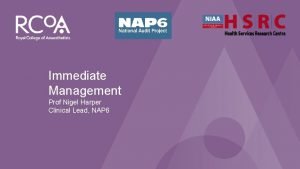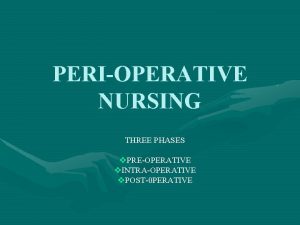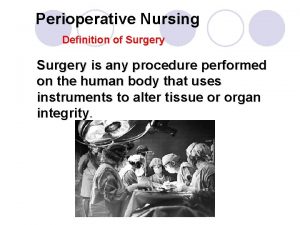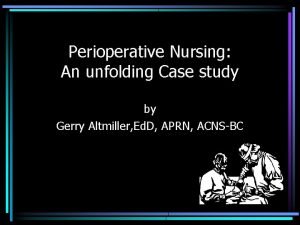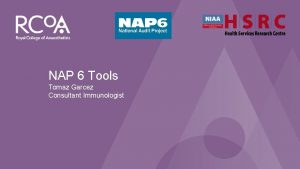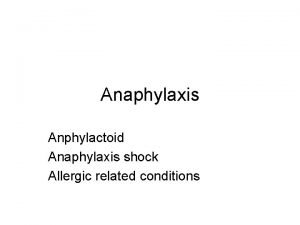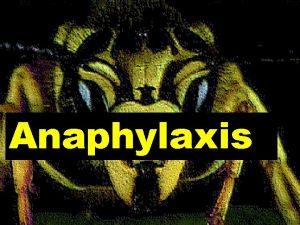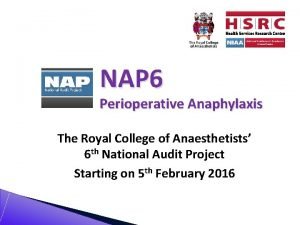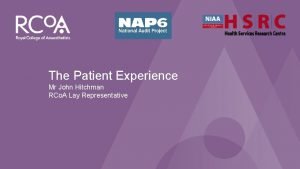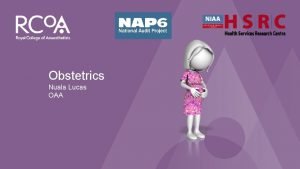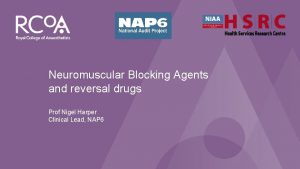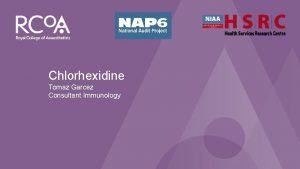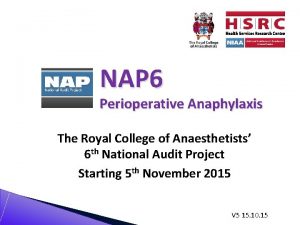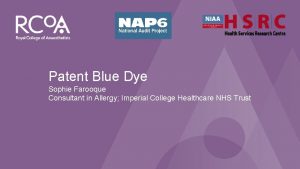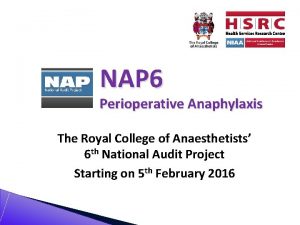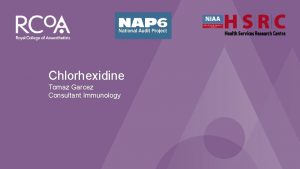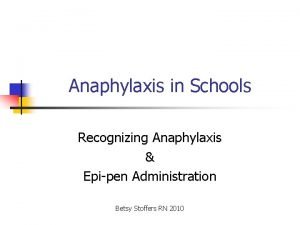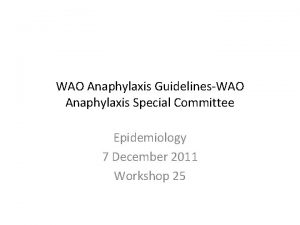NAP 6 Perioperative Anaphylaxis CLINICAL FEATURES Dr KL























- Slides: 23

NAP 6: Perioperative Anaphylaxis CLINICAL FEATURES Dr K-L Kong, MD MBBS FRCA, Consultant Anaesthetist Dr Surendra Karanam, BSc MBBS MRCP FRCPath, Consultant Immunologist

NAP 6: Perioperative Anaphylaxis WHAT WE ALREADY KNOW • Early recognition and prompt treatment of perioperative anaphylaxis vital. • Clinical diagnosis at presentation. • Knowledge of clinical features and high index of suspicion essential. • Recognition of anaphylaxis often delayed. • Key clinical features more commonly have non-allergic cause during perioperative period.

NAP 6: Perioperative Anaphylaxis NAP 6 ANALYSIS – PRESENTING FEATURE Cardiac arrest Nausea/vomiting Allergic Anaphylaxis Laryngeal oedema/Stridor All Patients Urticaria Bradycardia Decreased/Absent CO 2 trace Patient feeling unwell Cyanosis/Oxygen desaturation Flushing/non-urticarial rash Tachycardia Bronchospasm/High airway pressure Hypotension 0% 5% 10% 15% 20% 25% 30% 35% 40% 45% 50%

NAP 6: Perioperative Anaphylaxis NAP 6 ANALYSIS – ALL CLINICAL FEATURES Itching Nausea/vomiting Absent CO 2 trace Allergic Anaphylaxis All Patients Patient feeling unwell Bradycardia Cardiac arrest Urticaria Decreased CO 2 trace Cyanosis/Oxygen desaturation Tachycardia Bronchospasm/High airway pressure Flushing/non-urticarial rash Hypotension 0% 20% 40% 60% 80% 100% 120%

NAP 6: Perioperative Anaphylaxis NAP 6 ANALYSIS – OTHER FEATURES • • • Airway problems rarely seen. Isolated cardiovascular features: 15 (5. 6%) patients. Bronchospasm more common in asthma patients. Bronchospasm more common in morbidly obese patients. No difference in presenting or clinical features in patients with/without history of coronary artery disease. • Hypotension main presenting feature in patients taking betablockers or ACE inhibitors.

NAP 6: Perioperative Anaphylaxis NMBAs – Presenting features 80% 70% 60% 50% Bronchospasm/High airway pressure Flushing/Nonurticarial Rash 40% Hypotension Urticaria 30% 20% 10% 0% Atracurium rocuronium Suxamethonium

NAP 6: Perioperative Anaphylaxis ANTIBIOTICS – Presenting features 80% Bronchospasm/High airway pressure 70% Flushing/Nonurticarial Rash 60% 50% Hypotension 40% Reduced/Absent CO 2 Trace 30% 20% 10% 0% co-amoxiclav teicoplanin

NAP 6: Perioperative Anaphylaxis CHLORHEXIDINE & PATENT BLUE – Presenting features 60% 50% Cyanosis/Oxygen Desaturation 40% Flushing/Nonurticarial Rash Hypotension 30% Laryngeal Oedema/Stridor Other Tachycardia 20% Urticaria 10% 0% chlorhexidine patent blue

NAP 6: Perioperative Anaphylaxis Time from exposure to presenting feature (mins) Number (Percentage) of patients 0– 5 176 (66. 2%) 6 – 10 44 (16. 5%) 11 – 15 13 (4. 9%) 16 – 30 19 (7. 1%) 31 – 60 7 (2. 6%) 61 – 120 3 (1. 1%) > 120 2 (0. 75%) Blank 2

NAP 6: Perioperative Anaphylaxis Time from exposure to presentation - NMBAs 30 25 20 Atracurium Mivacurium 15 Rocuronium Suxamethonium 10 5 0 0 to 5 mins 06 to 10 mins 11 to 15 mins 16 to 30 mins Greater than 120 mins

NAP 6: Perioperative Anaphylaxis Time from exposure to presentation - Antibiotics 40 35 30 0 to 5 mins 06 to 10 mins 11 to 15 mins 16 to 30 mins 25 20 15 10 5 0 Cefuroxime Co-amoxiclav Flucloxacillin Gentamicin Metronidazole Piperacillin and Tazobactam Teicoplanin Vancomycin

NAP 6: Perioperative Anaphylaxis Time from exposure to presentation – Chlorhexidine and Patent Blue dye 8 7 6 0 to 5 mins 5 6 to 10 mins 11 to 15 mins 4 16 to 30 mins 31 to 60 mins 3 61 to 120 mins Greater than 120 mins 2 1 0 chlorhexidine patent blue

NAP 6: Perioperative Anaphylaxis Time to suspect and treat anaphylaxis • Speed of response by anaesthetist varies. • Response <10 mins when presenting feature was cardiac arrest, bradycardia, reduced/absent CO 2 trace, laryngeal oedema. • Longer delays when presenting feature was hypotension, bronchospasm/high airway pressure, cyanosis, nonspecific flushing.

NAP 6: Perioperative Anaphylaxis Reduced capnograph trace and unrecordably low oxygen saturation • Reduced/absent capnograph trace in 30% of cases. No clear correlation with grade of reaction. • Unrecordably low oxygen saturation reported in 31 cases. These reactions more likely grade 4 or 5, more rapid onset, and anaphylaxis more promptly suspected and treated.

NAP 6: Perioperative Anaphylaxis DISCUSSION (1) • More women with perioperative anaphylaxis proportional to more women undergoing surgery and anaesthesia. – NMBA anaphylaxis: twice as many women – Chlorhexidine anaphylaxis: preponderance of men • Hypotension universal during perioperative anaphylaxis. Consider anaphylaxis as differential diagnosis during unexplained perioperative hypotension. • Perioperative anaphylaxis can present as isolated organ system involvement.

NAP 6: Perioperative Anaphylaxis DISCUSSION (2) • Hypotension commonest presenting feature in anaphylaxis: – Atracurium (bronchospasm/high airway pressure with suxamethonium) – Chlorhexidine, Patent Blue dye and antibiotics, – Patients taking beta-blockers or ACE inhibitors. • Rapid onset for most culprit agents – Exceptions: chlorhexidine, Patent Blue dye, oral drugs

NAP 6: Perioperative Anaphylaxis DISCUSSION (3) • Clinical features of immediate concern and prompt recognition of anaphylaxis: cardiac arrest, reduced/absent CO 2 trace, laryngeal oedema. • Other relatively frequent clinical features during anaesthesia with causes unrelated to anaphylaxis – delay in recognition and treatment. • Bronchospasm/high airway pressure may be presenting feature of anaphylaxis in asthma patients.

NAP 6: Perioperative Anaphylaxis DISCUSSION (4) • Gouel-Cheron A et al. Br J Anaesth 2017; 119: 908 -17 – End-tidal CO 2 value <2. 6 k. Pa useful independent marker of severe anaphylaxis. – Potentially useful in early diagnosis of anaphylaxis as capnography readily/continuously monitored with routine GA. – Findings not confirmed by NAP 6 data. • NAP 6 data – Patients with unrecordably low O 2 saturation experienced severe reactions with early recognition and treatment by anaesthetist.

NAP 6: Perioperative Anaphylaxis KEY FINDINGS/RECOMMENDATIONS • Presenting features of perioperative anaphylaxis may have many other causes. • Early recognition key to successful treatment. • Anaphylaxis should be considered in unexpected perioperative hypotension. • Likewise in bronchospasm (asthmatic patients). • Perioperative anaphylaxis can present as isolated organ system involvement. • Cutaneous signs uncommon presenting features. • Majority of reactions present rapidly. • Education and training in recognition/treatment of anaphylaxis recommended.

NAP 6: Perioperative Anaphylaxis Thank you

NAP 6: Perioperative Anaphylaxis Urticaria and grade of anaphylaxis 40% 35% 30% Axis Title 25% Grade 3 20% Grade 4 Grade 5 15% 10% 5% 0% Urticaria No Urticaria Axis Title

NAP 6: Perioperative Anaphylaxis Grade vs age 35 30 25 20 Grade 3 Grade 4 15 Grade 5 10 5 0 01 to 5 06 to 15 16 to 25 26 to 35 36 to 45 46 to 55 56 to 65 66 to 75 76 to 85 86 to 95

NAP 6: Perioperative Anaphylaxis Grade vs ASA 70% 60% 50% 40% Grade 3 30% Grade 4 Grade 5 20% 10% 0% ASA 1 ASA 2 ASA 3 Figure 1. Grade of Anaphylaxis as per ASA status ASA 4
 Nap 6 summary
Nap 6 summary Brighton collaboration
Brighton collaboration Anaphylaxis classification
Anaphylaxis classification Anaphylaxis treatment
Anaphylaxis treatment Anaphylaxis onset
Anaphylaxis onset Anaphylaxis photos
Anaphylaxis photos Interprofessional care for anaphylaxis
Interprofessional care for anaphylaxis Causes of anaphylactic reaction
Causes of anaphylactic reaction Epiglotitis
Epiglotitis Lateral thigh injection site
Lateral thigh injection site Ig
Ig Anaphylaxis
Anaphylaxis Alfametildopa
Alfametildopa Hypersensitivity types and examples
Hypersensitivity types and examples Anaphlaxis
Anaphlaxis How to draw up epinephrine
How to draw up epinephrine Nap 6 recommendations
Nap 6 recommendations Latex allergy
Latex allergy Angioedema anaphylaxis
Angioedema anaphylaxis Pre-operative phase
Pre-operative phase Intraoperative care definition
Intraoperative care definition Perioperative nursing definition
Perioperative nursing definition Perioperative case study
Perioperative case study Canadian perioperative guidelines
Canadian perioperative guidelines
